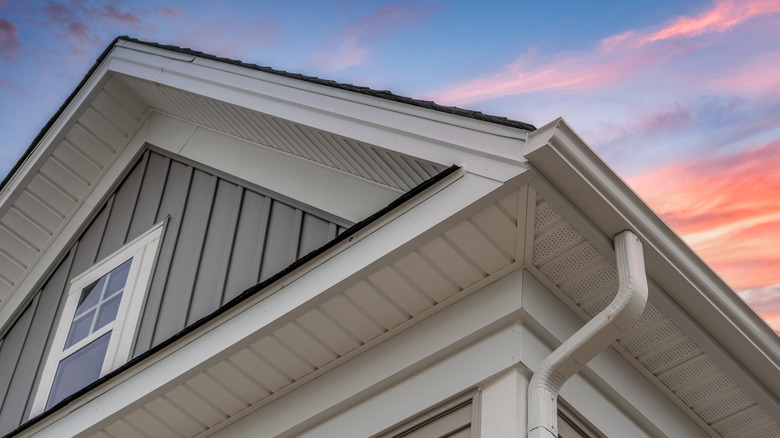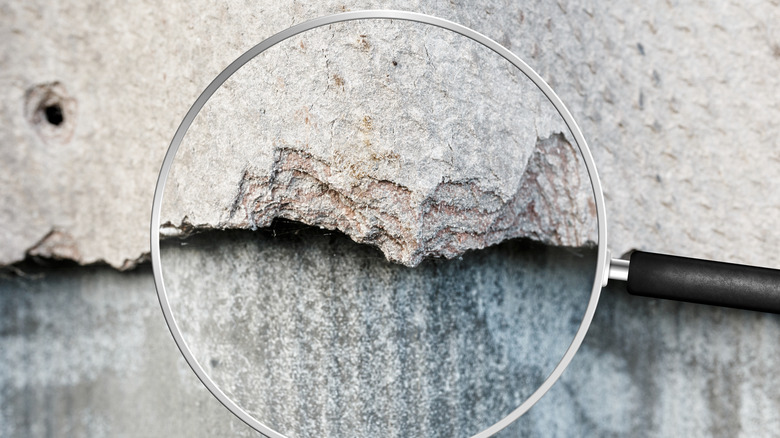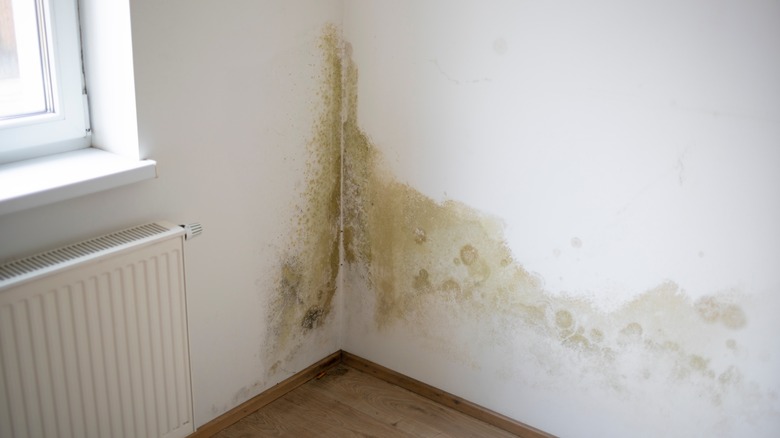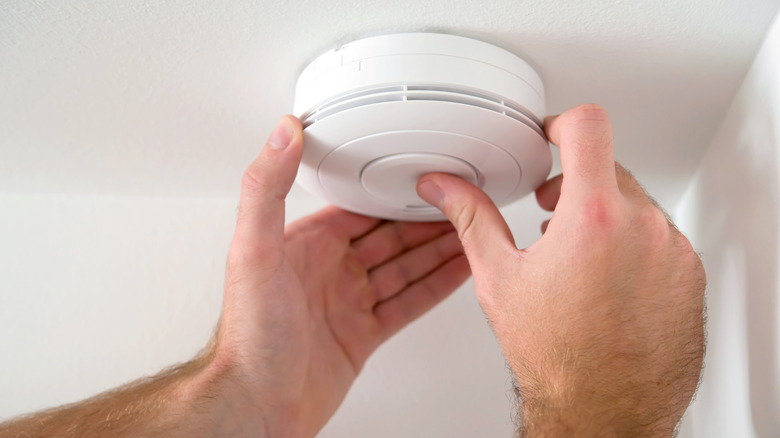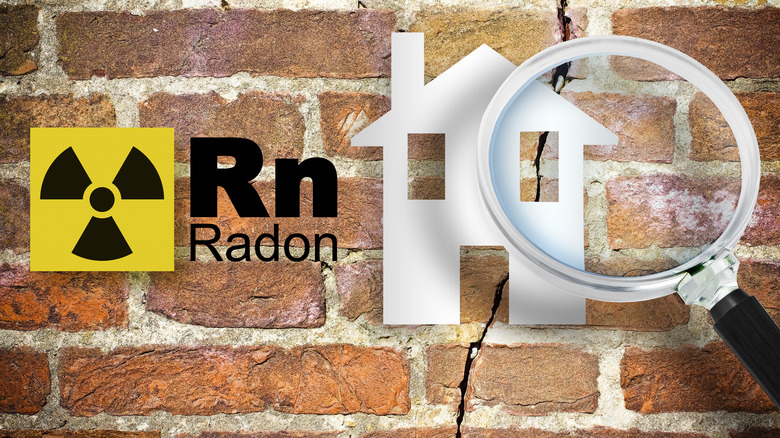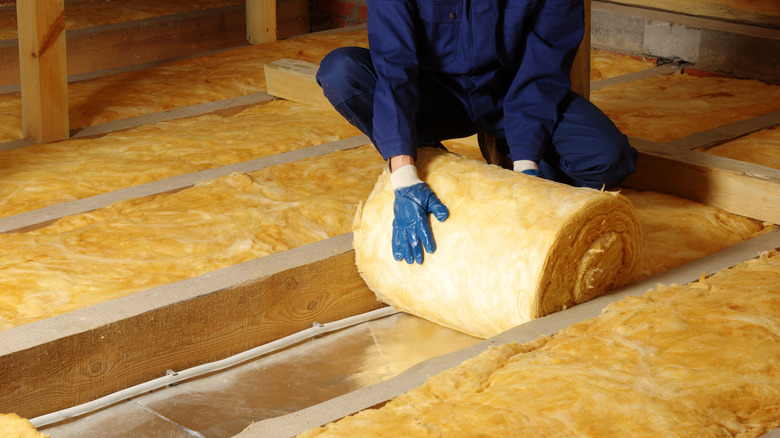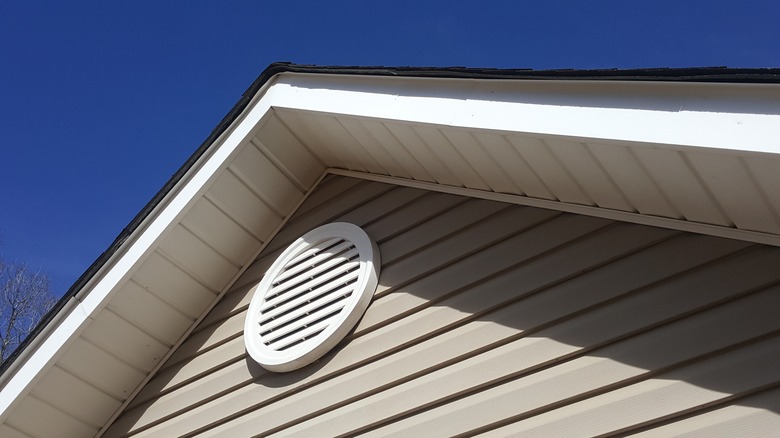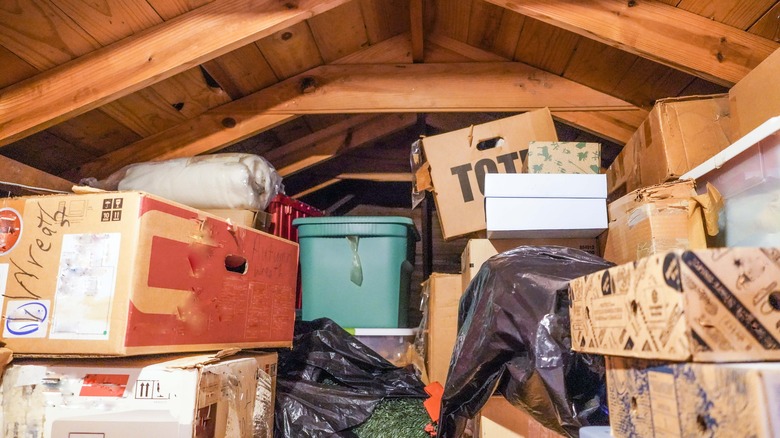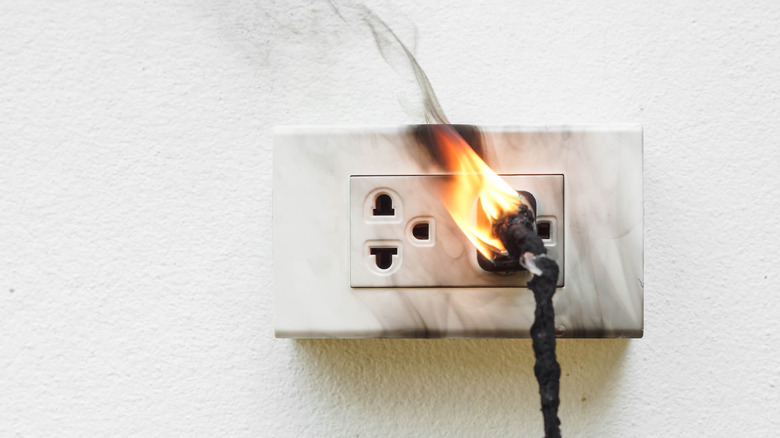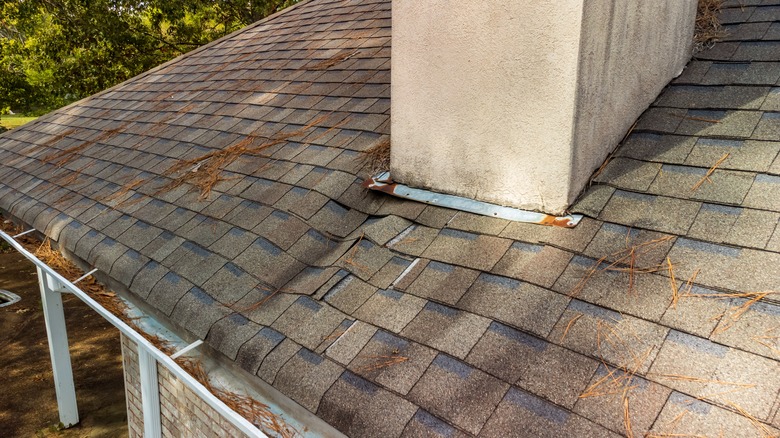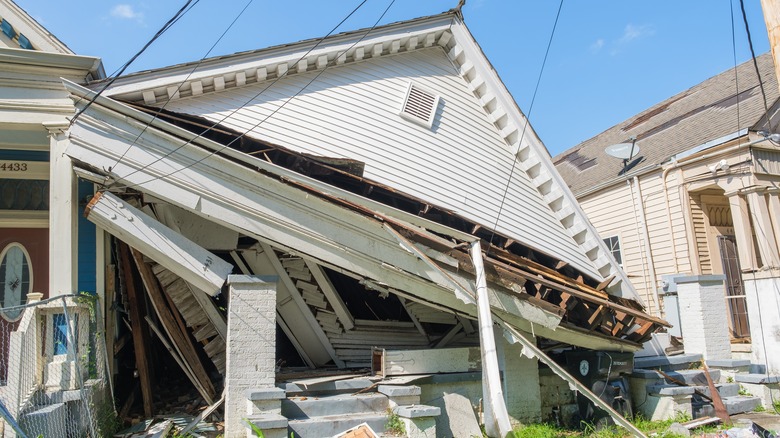Hidden Dangers That May Be Lurking In Your Attic
Things in your attic are typically out of sight, out of mind. You might only go up there a few times a year to grab some seasonal decorations or list old furniture on Facebook Marketplace. Yet ignoring problems in your attic might lead to expensive property damage, serious injury, or even death in some cases. If you don't check the status of things regularly, you could end up with a hefty bill, either from a contractor or the hospital. Good home maintenance means taking care of the parts you can see, plus forgettable spots, too.
Sure, some problems are easy to notice, like the raccoon you hear running above you every night. But other issues, like sparking from faulty electrical outlets or poisoning from asbestos and radon, can hurt you if you are not proactive. These are the most common hidden dangers in your attic and how to get ahead of them.
Asbestos
Asbestos is a mineral that was commonly used in building materials until the 1970s due to its excellent heat resistance, strength, and insulation properties. Developers thought it was an amazing substance until people started getting sick. That was when we discovered that prolonged exposure to asbestos fibers leads to serious health problems, including lung cancer and mesothelioma. Both of these diseases are extremely dangerous and often fatal.
If you have an older house, there is a high likelihood that there might be asbestos in the walls, ceilings, or attic. It is especially dangerous in the attic, as it might be completely exposed. If the fibers become airborne and you inhale them, you will become ill. It's not an "if" when breathing in asbestos, it's a "when." Asbestos-containing materials in good condition and undisturbed are not usually a health risk. However, if the materials are damaged or disturbed, like during renovations or repairs, that is when things get dangerous.
If you have the slightest suspicion there might be some present based on the age of your home or any health changes, have a professional asbestos abatement company inspect your attic immediately. If the team finds any, they can safely remove it and properly dispose of it to minimize the risk of exposure to you and your family.
Toxic mold
Mold in your attic is a deadly danger you might not catch until it's too late. Unfortunately, mold is very easy to form, especially if you live in a more humid climate. People who live in the states around the Gulf of Mexico or along the southern end of the eastern seaboard should be the most vigilant about mold. Mold can form in an attic for many reasons, including poor ventilation, high humidity levels, moisture infiltration from leaks in the roof, or condensation from HVAC ducts. If not taken care of swiftly, the mold spores can settle and begin to grow quickly. They can take over the insulation, wood, and even the drywall. Once enough has grown, it can release spores into the air, circulating throughout your home.
Prolonged mold exposure can really hurt you, especially if you are sensitive or allergic to it. Breathing in mold spores can cause respiratory problems, like coughing, wheezing, and overall difficulty breathing. If you have asthma, mold exposure will make it worse. In some extreme cases, mold can cause brain fog, extreme mood swings, constant ringing in the ears, and hair loss. If you suddenly develop these symptoms, mold in the attic might be to blame. To protect yourself, address any sources of moisture in your attic, improve its overall ventilation, and ensure that it is adequately insulated. As a final precaution, conduct regular visual checks for the presence of mold.
Carbon monoxide
If there is a gas furnace or other fuel-burning appliance in the attic, it can produce carbon monoxide (CO). CO is a colorless and odorless gas that can be deadly if inhaled in high concentrations. CO does the most damage in enclosed spaces with inadequate ventilation ... like attics. CO is not only deadly to humans but pets, too. This risk is why miners kept canaries in coal mines in the olden days. The gas killed the birds much faster than humans due to their small size. So if the bird died, humans knew they needed to leave ASAP.
Because you can't smell, taste, or see carbon monoxide, it's often too late to realize something might be wrong. When you breathe in CO, it binds to hemoglobin in your blood. This prevents oxygen from being transported to your body's tissues. You will become very sick very quickly. Your head will start to hurt; you will feel nauseous and dizzy, then very confused. These symptoms appear in rapid succession; then, you lose consciousness. By then, it's too late unless someone in a gas mask pulls you out to safety nearly immediately. Instead of keeping a canary on hand, install a carbon monoxide alarm near your attic. This way, you will be able to evacuate before symptoms set in.
Radon
Radon is a naturally occurring radioactive gas. It comes from the breakdown of any uranium in the soil, rocks, and water near our homes. This colorless, odorless gas can seep into homes through cracks in the foundation or walls. If your attic is not properly sealed, radon can accumulate and pose an extreme health risk. Breathing in radon damages the cells that line your lungs, increasing the risk of lung cancer. In fact, radon is one of the leading causes of lung cancer in the United States, second only to smoking. According to the CDC, radon exposure is responsible for about 21,000 lung cancer deaths in the country each year.
Of course, the overall risk of developing cancer is based on a few moving parts. You have to consider the amount of radon in the air, the length of time a person is exposed, and individual factors, like smoking and genetics. However, even low levels of radon can pose a risk over time. This is why you should test for radon in your home at least once every few years. You can hire a company or even purchase a DIY kit from your state. If the levels are higher than 4 pCi/L, you need to contact a professional agency to help you reduce your risk.
Poor insulation
If your attic is not properly insulated, the freezing air circulating in the winter can lead to frostbite or hypothermia for anyone working or spending time in the attic. In the summer, excessive heat and moisture can cause your roofing materials to deteriorate more quickly, leading to costly repairs or replacements, as well as potential collapse. A poorly insulated attic can also make rooms directly beneath it too hot in the summer and too cold in the winter, leading to discomfort and a dangerously high electric bill as you try to counteract the temperature.
If you live in an area where it snows, poor insulation can cause ice dams. When heat escapes through the roof, it can melt snow on the roof, which then refreezes at the roof's edges. These dams can prevent proper drainage and cause water to seep under the shingles, leading to leaks and damage to your roof and interior. The heavy weight can also rip off your gutters, creating an expensive problem. Instead, ensure your attic's insulation is up-to-date to get ahead of any problems.
Household chemicals
If you store chemicals in the attic, they can pose a health risk if they are not stored correctly or spill. If your attic is easily accessible, it makes sense that you might choose to use it as a storage space. However, if you decide to keep any cleaning items in the attic, make sure to store them safely. For example, antifreeze, also known as engine coolant, is a liquid used in vehicles to regulate engine temperature and prevent overheating. While it is effective at its intended purpose, antifreeze can also be dangerous if ingested by humans or animals. If it's not stored correctly, it has the potential to spill and leak into air ducts, causing respiratory harm. In addition, pests like rats or raccoons could get into the bottle. Once ingested, death isn't far behind, then you have to deal with an animal carcass, which is a major health hazard in and of itself.
Other chemicals to be wary of are bleach, drain cleaners, ammonia, carpet cleaners, and even air fresheners. While you might not be aware, many air fresheners contain formaldehyde as a preservative. This chemical can make you sick, causing anything from something small like a cough to big things like cancer in your respiratory tract. It can easily become dangerous if you store it in an enclosed space like an attic.
Poor ventilation
In the summer, attics with poor ventilation can become very hot. This can lead to heat exhaustion or heat stroke for anyone working or spending time in the attic. Heat sickness can come on very suddenly. Symptoms include slurred speech, dizziness, profuse sweating, loss of consciousness, and even seizures and death.
If you simply use your attic for storage and don't spend much time up there, you might think that ventilation won't be an issue. Yet poor ventilation can wreak havoc on homes even without causing heat stroke. Air that can't move easily becomes stagnant. If there is humid weather outside or a small leak in the roof, wet air will seep into the still space. This can lead to mold and mildew growth, which can cause health problems for residents and structural damage to the home. Wet, stagnant air can also cause the wooden beams that support the roof to rot. This damage makes the roof significantly more vulnerable to cave-ins, which can harm those down below.
You can counteract this by installing vents so a breeze can run across your attic, especially if it is not a temperature-controlled space. These vents also allow the hot air rising out of your home the perfect place to escape. Attics should also be well-insulated (even if the insulation remains exposed) to help prevent moisture build-up and keep the temperature more consistent.
Falling objects
Attics come in all shapes and sizes. Some are tiny crawl spaces accessible only by a small ladder, while others are sprawling rooms with a full staircase. While the room's shape and size influence its primary use, most families use attics just for storage. It can be tempting to cram as many pieces of old furniture and holiday decorations into the attic as possible, but they can easily shift or fall and cause injury to anyone below.
When packing your attic, pay special attention to how you arrange the items. You should place heavier things like a crib or an old desk nearer the entrance to avoid more work getting them back out. However, be wary of stacking baskets and boxes on top of these larger items, as you might jostle them when entering, causing them to fall on you. Instead, if you need to stack anything, do so way back from the door. To avoid falling objects, it's also worth investing in more uniform storage solutions for your attic items. Don't keep things in multi-size cardboard boxes that can break down, sag, and tumble down over time. Instead, consider same-size plastic containers. This way, you can safely stack things higher up without worrying they will fall and hit you.
Potential pests
Attics can be a haven for rodents, bats, and insects like termites and cockroaches. Mammals like rats, raccoons, and squirrels also commonly live in attics. They scamper over from nearby trees and make a cozy nest among the insulation. But it's dangerous for them to be there, as they can chew on electrical wiring, insulation, and wooden beams. This can lead to electrical fires and compromise the structural integrity of your home. Pests such as termites and cockroaches can quickly multiply and cause infestations, which can be difficult and expensive to eradicate. Soon enough, the infestation won't be confined to just your attic, either.
But even if the animals don't multiply into the thousands and damage your home, they still might die or get you sick. Some animals can carry diseases that can be transmitted to humans, like bats and their feces, which can contain harmful fungi and bacteria that cause respiratory problems. Some raccoons carry roundworm and even rabies, which is fatal if you don't catch it before symptoms appear. Should an animal succumb to these diseases (or be electrocuted while chewing on wiring, suffocating, etc.), you must rid your home of a dead animal, which is a significant health hazard. It's even worse as you typically don't realize the animal has passed until you start to smell it.
Electrical hazards
Some of the scariest dangers lurking in your attic are electrical hazards. According to the National Fire Protection Association, nearly 47,000 house fires in the United States each year are caused by electric issues, with almost 400 deaths. These fires cause an annual $1.5 billion in damages to homes. While electrical problems in high-traffic areas might be easier to spot and fix, problems in the attic often go unnoticed, leading to tragedy. To avoid this, have a licensed electrician inspect your attic to identify any potential electrical hazards and make the necessary repairs or upgrades.
For example, the electrician should safely cover any exposed wires. Wires may become exposed due to improper installation or accidental damage. Exposed wires can be a major fire hazard due to sparking, but they can also pose a risk of electrocution if touched. In addition, if your home is older, its dated wiring may not handle the electrical load of modern devices. This causes it to get brittle and crack over time, increasing the fire risk. Finally, if you installed any wiring in your attic yourself, perhaps an overhead light or a fan, have your work checked. Improperly installed DIY work poses a high risk of fire or electrocution.
Roof leaks
Most of us don't go into our attics daily, so things like small roof leaks can easily get out of hand before we notice them. Roof leaks cause so much damage to our homes. Even if they are just a slow dribble, the moisture begins to rot away at the wood and insulation surrounding the source of the leak. As the water pools, it does the same to the wooden beams underneath it. Even a small leak can cause substantial damage to the structural integrity of your home over time, not to mention ruining the belongings it drips down onto. In some cases, a roof leak leads to full-on flooding of a space.
If the leak is near electrical wiring or fixtures, it can pose a risk of electrical fires as the wires become wet. Plus, the moisture from a leak can lead to mold growth, which can cause respiratory problems, allergic reactions, and other health issues. Mold can also spread quickly and be difficult and expensive to remove. It is important to regularly inspect your roof for signs of damage or wear and tear to catch any potential issues early. If you find any weak spots on your roof or signs of damage in your attic, consult a professional roofer to identify the source of the leak and make the necessary repairs.
Structural damage
The cumulation of all these threats is structural damage. Because of this, you need to inspect your attic's floor and roof supports for damage or weakness. Should any soft spots be left untreated for long, they can lead to roof collapses. These collapses can be expensive or deadly, or both, depending on where you are when they occur. One of the main things that can lead to damage is a build-up of moisture, which weakens the integrity of any wood in the attic. This is only worsened by poor ventilation and a few hungry little pests.
If you have a leak that goes unnoticed, it can cause floorboards to rot. A little raccoon comes along and makes her nest in the weak spot and before you know it, a chest of drawers comes crashing down through the soft spot in the ceiling. In addition to preventing new weak spots from forming, it's important to consider the ones that have been there since the beginning when storing things upstairs. That is, store lighter items in unreinforced attic areas and heavier ones near load-bearing walls.
